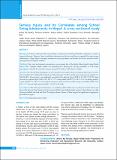Please use this identifier to cite or link to this item:
https://hdl.handle.net/20.500.14356/1308Full metadata record
| DC Field | Value | Language |
|---|---|---|
| dc.contributor.author | Pandey, Achyut Raj | - |
| dc.contributor.author | Neupane, Tamanna | - |
| dc.contributor.author | Chalise, Binaya | - |
| dc.contributor.author | Chaudhary, Sabina | - |
| dc.contributor.author | Shrestha, Niraj | - |
| dc.contributor.author | Bista, Bihungum | - |
| dc.date.accessioned | 2023-05-04T11:03:47Z | - |
| dc.date.available | 2023-05-04T11:03:47Z | - |
| dc.date.issued | 2020 | - |
| dc.identifier.citation | PandeyA. R., NeupaneT., ChaliseB., ChaudharyS., ShresthaN., & BistaB. (2020). Serious Injury and its Correlates among School Going Adolescents in Nepal: A cross-sectional study. Journal of Nepal Health Research Council, 18(3), 506-512. https://doi.org/10.33314/jnhrc.v18i3.2882 | en_US |
| dc.identifier.issn | Print ISSN: 1727-5482; Online ISSN: 1999-6217 | - |
| dc.identifier.uri | http://103.69.126.140:8080/handle/20.500.14356/1308 | - |
| dc.description | Original Article | en_US |
| dc.description.abstract | Abstract Background: Injury-related mortality and morbidity, a leading cause of death and disability worldwide, is common among adolescents. However, there is insufficient information on the status and factors responsible for injury among adolescents in Nepal. Hence, the paper estimates the injury prevalence and identify the factors associated with it among adolescent Nepalese students. Methods: This study used national representative cross-sectional data of the Global School-based Student Health Survey 2015. Complex sample analysis was performed after adjusting the selection probability of each sample participants to identify the correlates of injury among 6529 students of 68 schools in Nepal. Results: Out of 6529 study participants, 62.79% reported severe injury. The most common injury type was cut or stab wound (67.61%) followed by broken bone/dislocated joints (11.03%) and the most common cause of injury was fall (56.40%). Serious injury was significantly associated with a physical attack (AOR=1.54, CI=1.17-2.04), being involved in a physical fight (AOR=1.62, CI=1.2-2.2), being bullied (AOR=2.73, CI=2.25-3.31), feeling unsafe at school (AOR=1.53, CI=1.23-1.91), helmet use(never/rarely/sometimes) while driving a motorbike (AOR=1.69, CI=1.21-2.38) and drink and drive(AOR=2.28, CI=1.05-4.96). Conclusions: This study reported the injury as a significant public health concern in Nepal associated with several factors like physical attack, being involved in a physical fight, being bullied, feeling unsafe at school, helmet use while driving motorbike and drink and drive. The high prevalence of injury in Nepal suggests the application of appropriate prevention strategies. Keywords: Adolescents; injury; Nepal | en_US |
| dc.language.iso | en | en_US |
| dc.publisher | Nepal Health Research Council | en_US |
| dc.relation.ispartofseries | Jul-Sep 2020; | - |
| dc.subject | Adolescents | en_US |
| dc.subject | Injury | en_US |
| dc.subject | Nepal | en_US |
| dc.title | Serious Injury and its Correlates among School Going Adolescents in Nepal: A cross-sectional study | en_US |
| dc.type | Journal Article | en_US |
| local.journal.category | Original Article | - |
| Appears in Collections: | Vol. 18 No. 3 (2020): Vol. 18 No. 3 Issue 48 Jul-Sep 2020 | |
Files in This Item:
| File | Description | Size | Format | |
|---|---|---|---|---|
| 2882-Manuscript-18850-1-10-20201115.pdf | Fulltext Article. | 171.59 kB | Adobe PDF |  View/Open |
Items in DSpace are protected by copyright, with all rights reserved, unless otherwise indicated.
